Electro Harmonix Stereo Talking Machine Handleiding
Electro Harmonix
Niet gecategoriseerd
Stereo Talking Machine
Bekijk gratis de handleiding van Electro Harmonix Stereo Talking Machine (12 pagina’s), behorend tot de categorie Niet gecategoriseerd. Deze gids werd als nuttig beoordeeld door 71 mensen en kreeg gemiddeld 4.9 sterren uit 36 reviews. Heb je een vraag over Electro Harmonix Stereo Talking Machine of wil je andere gebruikers van dit product iets vragen? Stel een vraag
Pagina 1/12

1
STEREO TALKING MACHINE
Vocal Formant Filter
Congratulations on your purchase of the Electro-Harmonix Stereo Talking Machine, a
highly customizable envelope-controlled digital vowel filter. The Stereo Talking
Machine (STM) utilizes multiple moving filters to turn your guitar in a growling,
gurgling, snarling monster.
- Special Features of the Stereo Talking Machine -
• Nine selectable voices: Seven human vowel filter combinations, a classic wah-wah filter,
and the legendary dual band filter of the EHX Bassballs
• Ability to reverse the sweep of each voice, doubling your sound options
• Attack/Decay knobs to separately control the rise and fall speeds of the filter sweep
• Sensitivity control to adapt the effect’s response to your playing style
• Stereo Outputs for true stereo imaging and panning
• Expression Pedal option to manually control filter sweep
• Programmable distortion to make your guitar really growl
• Programmable internal LFO for automatic filter modulation
• Effects Loop side-chain
• 9 fully programmable presets
– – VOICE DESCRIPTIONS
Each voice option in the STM sweeps between two distinct filter settings, mimicking
the way a human mouth moves to form particular vowel sounds. The direction of the
filter sweep can be reversed using the SENSITIVITY knob.
Sensitivity +
Sensitivity -
EE
F d ee
Cer l ea
EE ER-
Hurry
Peer
AH-I
Glide
Papaya
AH- OO
Fact l ua
N ow
I-A
H ght ei
B net ayo
AH
E ra
F ar
OW- EE
F d eu
Chewy
The WAH and BB voice options simulate a classic wah-wah pedal filter and the EHX
Bassballs filter respectively.
WARNING: Your Stereo Talking Machine comes equipped with an Electro-
Harmonix 9.6DC-200 power supply (same as used by Boss® & Ibanez®: 9.6 Volts
DC 200mA / Center Negative). The Stereo Talking Machine requires 185mA at
9VDC with a center negative plug. The STM does not take batteries. Using the
wrong adapter may damage your unit and void the warranty.

2
– QUICK START GUIDE –
This Quick Start Guide will help you get started using your Stereo Talking
Machine immediately. For detailed information on all of the Stereo Talking
Machine's features and functions, please refer to the rest of this owner’s manual.
Setup
1. Using an unbalanced instrument cable, plug the output of your instrument
into the INPUT jack on the right side of the STM.
2. Connect an unbalanced instrument cable from the MONO/L output jack on
the left side of the STM to the input jack of an amplifier.
3. Connect the included AC Adaptor to a wall outlet and plug its barrel
connector into the 9V power jack at the top of the STM.
4. Turn on the amplifier and turn up your instrument’s volume. Press the
BYPASS footswitch so that the STATUS LED is lit; the STM is now activated.
A. Preset Settings
Press and release the PRESET footswitch to cycle through the STM’s preset
settings. Each factory preset has been carefully prepared to utilize the deep
sonic capabilities of the STM. You may overwrite the factory presets with
your own sound creations whenever you like.
B. Manual Settings
1. To begin, turn the STM’s knobs to the following positions:
BLEND:
Full Clockwise
VOICE:
Full Clockwise (OW- EE)
ATTACK:
12 o’clock
DECAY:
12 o’clock
SENSITIVITY:
1 o’clock
2. Ensure the PRESET LED (bottom left) is off. If it is on, turn the white
PRESETS knob clockwise until the PRESET LED shuts off. This action
deactivates the currently loaded preset.
3. Ensure the auxiliary functions (indicated by the leftmost orange LED) are
off. If they are on, press the white PRESETS knob to deactivate them.
4. Play your instrument at the intensity you would like to trigger the filter
sweep. While playing, turn up the SENSITIVITY knob until the Sweep Level
LEDs light up completely after each note you play.
5. To change the sweep speed of the filters, adjust the ATTACK and DECAY
knobs.
6. Adjust the VOICE knob to try different voicings or filter types.
– – SWEEP LEVEL LEDs
The two rightmost orange LEDs under the PRESETS knob indicate the position
of the filters at any given moment. When the LEDs are both unlit, the filters are
at their rest position (ex: set to OW for the positive OW-EE voice). When the
LEDs are both lit, the filters are in their maximum position (ex: set to EE for the
positive OW-EE voice). The LEDs sweep on and off, visually representing the
audible sweep of the filters as the input signal triggers the envelope sweep, the
expression pedal manually moves through the filters or as the internal LFO
automatically modulates the filters.

3
– – PRIMARY KNOB FUNCTIONS
BLEND – Controls the wet/dry balance of the effect outputs. Turning the BLEND
knob to its minimum counter-clockwise position will yield 100% dry signal with no
wet. Turning the BLEND knob to its maximum clockwise position will give 100% wet
signal with no dry. A mix of the wet and dry signals will occur when BLEND is set
anywhere between the extreme settings.
VOICE Type – Selects one out of the nine voice options. Turning the VOICE knob
will change the filter type affecting the wet signal. A corresponding LED in the LED
ladder will blink briefly when a new VOICE is selected, indicating the change. The
STM does not blend between the nine voices. The VOICE knob acts like a switch;
moving it within a single voice will not produce varying results. To reverse the
polarity of the voice type, see the SENSITIVITY knob.
ATTACK – Varies the rise time of the filter sweep. The rise time is the speed at
which the envelope generator travels from its rest position to its maximum position.
With the ATTACK knob set to its counter-clockwise position, the filters rise at the
fastest rate (8 mS); set to its clockwise position, the filters rise at the slowest rate
(1200 mS).
DECAY – Varies the fall time of the filter sweep. The fall time is the speed at which
the envelope generator travels from its maximum position to its rest position. The
filter sweep’s decay begins after the ATTACK time has finished. With the DECAY
knob set to its counter- ockwise position, the filters fall at the fastest rate (8 mS); cl
set to its clockwise position, the filters fall at the slowest rate (1300 mS).
SENSITIVITY
(w/ voice polarity)
– Controls the input volume at which the filters
will start moving, varying the STM’s responsiveness to the instrument’s dynamics.
The SENSITIVITY knob has a center detent which signifies the off position for no
envelope response (a good position for use with an expression pedal). Turning the
knob away from the center detent will make the STM more responsive to your
playing. For chords and hard plucking, set the knob near the center. For single notes
and softer strumming, set the knob far from the center.
The SENSITIVITY knob is split into two sections: In the positive (clockwise)
half of the knob, the voice filters will sweep in the forward direction (ex: OW->EE for
the OW-EE voice or from low to high frequency for the WAH and BB voices). In the
negative (counterclockwise) half of the knob, the voice filters will sweep in the
reverse direction (ex: EE->OW for the OW-EE voice or from high to low frequency
for the WAH and BB voices).
Product specificaties
| Merk: | Electro Harmonix |
| Categorie: | Niet gecategoriseerd |
| Model: | Stereo Talking Machine |
Heb je hulp nodig?
Als je hulp nodig hebt met Electro Harmonix Stereo Talking Machine stel dan hieronder een vraag en andere gebruikers zullen je antwoorden
Handleiding Niet gecategoriseerd Electro Harmonix
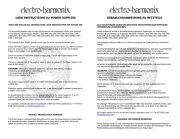
5 Augustus 2025
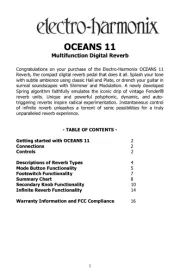
5 Augustus 2025
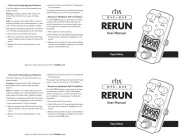
5 Augustus 2025
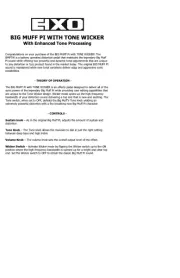
5 Augustus 2025
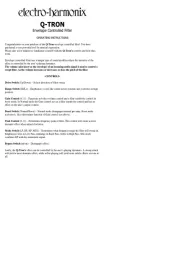
5 Augustus 2025
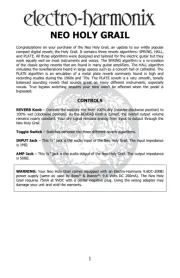
4 Augustus 2025
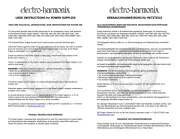
4 Augustus 2025
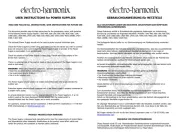
4 Augustus 2025
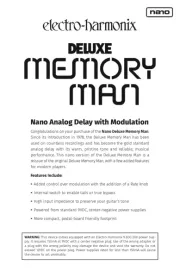
4 Augustus 2025
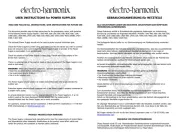
4 Augustus 2025
Handleiding Niet gecategoriseerd
- Raveland
- Arebos
- Orava
- Sky-Watcher
- Covercraft
- Cosina
- REV
- Qplay
- Gator Frameworks
- Anslut
- Huslog
- ChyTV
- Gima
- Janitza
- Hawk-Woods
Nieuwste handleidingen voor Niet gecategoriseerd

14 September 2025

14 September 2025

13 September 2025

13 September 2025

13 September 2025

13 September 2025

13 September 2025

13 September 2025

13 September 2025

13 September 2025